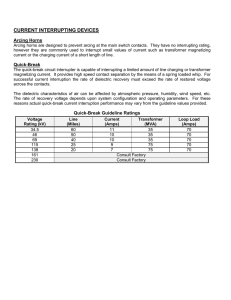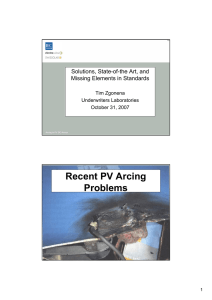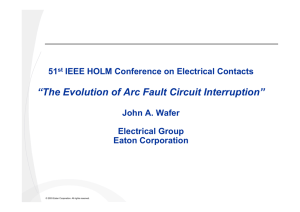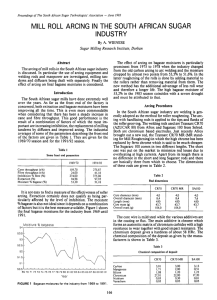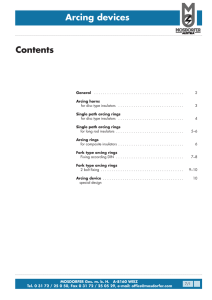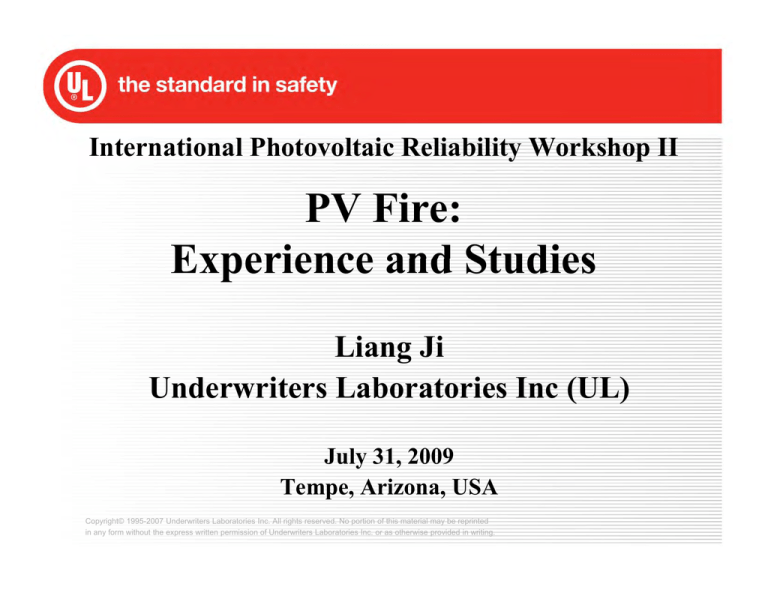
International Photovoltaic Reliability Workshop II
PV Fire:
Experience and Studies
Liang Ji
Underwriters Laboratories Inc (UL)
July 31, 2009
T
Tempe,
A i
Arizona,
USA
Copyright© 1995-2007 Underwriters Laboratories Inc. All rights reserved. No portion of this material may be reprinted
in any form without the express written permission of Underwriters Laboratories Inc. or as otherwise provided in writing.
PV Fire Study
y
There are two major considerations for
fi safety
fire
f
off photovoltaic
h
l i systems:
y PV components
p
and
1. Fires caused by
systems
2. Fires caused by external sources
2
PV Arcing
g-1
To grid
S
P
P
S
P
AFCI
P
Inverter
Transformer
S
Module
G
G
AFCI (Arc Fault Circuit Interrupter)
S – Series
S i Arcing
A i
P – Parallel Arcing
G – Grounding Arcing
3
PV Arcing
g-2
Simulation test at UL on 1/24/2007
4
PV Arcing
g-3
Photo from: Peter Kremer, VDE and DIN
5
Parallel Arcing
g
•Parallel arcing
g is
caused by a short
between positive
and
d negative
i wires.
i
•It is considered as
a double-failure,
t e e o e; has
therefore;
as not
ot
received high
priority now.
The middle two bus
bars could cause a
parallel arcing – the
spacing is too close.
6
Testing
g for Arcing…Needs
g
• Developing new test methods
related to arcing caused by PV
modules balance of system (BOS)
modules,
and system installations.
• Improving requirements for PV
module polymeric materials to
minimize spread of fire, if an arcing
occurs.
7
AFCI Research
Under the support of SAI (Solar America
Initiative) SolarABCs (The Solar America Board
Initiative),
for Codes and Standards)
http://www.solarabcs.org/
ttp //
so a abcs o g/
UL is conducting a PV AFCI (Arc Fault Circuit
Interrupter) research to develop correspondent
requirements (not the product design or
product itself).
It may be added to NEC 2011. NEC (National
Electrical Code),
) update every
y3y
years.
8
PV Arc and Fire 2/10/2009
B f
Before
th
the fire
fi
9
PV Arc and Fire 2/10/2009
10
Two Other PV Fires
BIPV Fire 3/8/2009
It shows that with some BIPV installations,
installations
partial shading is “normal operation
condition”,, twice or more everyday
condition
PV Arc and Fire 4/5/2009
Installation could cause a big problem. In
this situation, the long conduit slipped out
f
from
the
th joint,
j i t and
d cutt the
th wires’
i
’ insulation
i
l ti
inside, caused a big arc
11
IEC/UL PV Module Fire Test
Fire test on following standards are similar:
•
IEC 61730-2:2004 Photovoltaic (PV) module safety
qualification – Part 2: Requirements for testing
Clause 10
10.8
8 Fire test MST 23
•
ANSI/UL 1703-2004 (R2008) Flat-Plate Photovoltaic
Modules and Panels
Section 31 Fire Tests
ANSI/UL 790-2004
790 2004 (R2008) Standard Test Methods
for Fire Tests of Roof Coverings
Section 7 Spread-of-Flame Test
Section 8 Burning-Brand
Burning Brand Test
•
12
IEC/UL PV Module Fire Test
Parameter
Class A
Class B
Class C
Pit h off PV Modules
Pitch
M d l
22 6° (or
22.6°
( per manufacturer
f t
if it > 22.6°)
22 6°)
Min. Module Width (m)
1.0
Min. Module Length (m)
1.8
Wind speeds (m/s)
2.4
3.9
5.3
Spread-of-Flame Test
Flame Temperature (°C)
760
760
704
Test Duration (min)
10
10
4
Brand type
Brand Size (mm)
Number of Brands
Burning-Brand Test
kiln-dried
kiln
dried Douglas fir lumber
free from knots and pitch pockets
300X300X57
150X150X57 38.1X38.1X19.8
1
2
20
13
European Fire Test
For the external fire performance of roofs, a harmonized classification
system and related test methods have not been introduced so far.
A tests are acceptable for
All
f C
CE mark.
Parameter
Test 1
Test 2
Test 3
O i i l standard
Original
t d d
DIN
AFNOR
BS
Country
Germany
France
UK
Specimen size (m)
0 8 x 1.8
0.8
18
NORD
Nordic
Countries *
0 4 x 1.0
0.4
10
1 2 x 3.0
1.2
30
Pitch of test specimen
15° or 45°
30°
5° or 30°
00.84
84 x 0.84
0 84
45° or
horizontal
Brand type
Wind speeds (m/s)
Radiation levels
wood wool
in basket
not specified
not applied
radiation
di ti
wood crib
2
not applied
radiation
di ti
Test 4
fiber board
brands
2 and 4
12.5 kW/m²
gas flame
6.7
12.5 kW/m²
* Denmark, Finland, Iceland, Norway and Sweden
14
Fire Test Comparison
p
Comparing previous two tables, we can see, the
t t methods
test
th d and
d requirements
i
t diff
different.
t
There are differences of opinions on which one
is more severe, or if one test can substitute
for the other. Also,, which fire test methods
are most relevant for different fire scenarios?
One thing is clear:
We need “national differences” .
15
IEC/UL Spread
p
of Flame Test
16
IEC/UL Burning
g Brand Test
17
SAI PV Fire Research - 1
Under the support of SAI (Solar America
I iti ti ) SolarABCs
Initiative),
S l ABC (The
(Th Solar
S l America
A
i
Board for Codes and Standards)
htt //
http://www.solarabcs.org
l
b
UL is
i conducting
d ti
fire
fi test
t t simulations
i l ti
to
t
determine if and how PV modules affect
roofing materials in the event of building fires.
fires
18
SAI PV Fire Research - 2
As a result of catastrophic fires in California,
th St
the
State
t Fire
Fi Officials
Offi i l are preparing
i to
t
implement a statewide requirement for
Class A fire rating of all roofing products
products.
They have been considering requiring that all
PV modules obtain Class A rating as well.
However to-date, there are few Class A rated
PV modules or BIPV products,
products out of
hundreds of listed PV modules.
19
SAI PV Fire Research - 3
This new UL PV Fire Research Project
j
will:
• provide critically needed test data to
develop
p the appropriate
pp p
requirements;
q
;
• answer pertinent industry questions and
issues
ssues assoc
associated
ated with
t tthe
e use o
of PV
modules over Fire-Class rated roofing
materials.
20
SAI PV Fire Research - 4
The research will have several phases:
1. study the interaction of the panel and the
roof during fire tests (gap heights, leading
edges);
2. study different combinations of PV
modules and roofing materials
(Class C PV module + Class A roof = ?).
For latest information and result:
http://www.solarabcs.org
p
g
21
Thanks!
Contact Information
Liang Ji
Li
Underwriters Laboratories Inc (UL)
Email: <liang.ji@us.ul.com>
22

